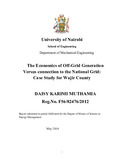| dc.description.abstract | It is a well-known fact that electricity is essential for national development and many third
world developing economies, have prioritized adequate energy provision to its populace as a
key economic pillar. Despite this, many regions in these countries remain unconnected to
electric power grids. Today, only about 35% of Kenyans have access to the country’s electricity
grid. Principal alternatives to connecting the remaining users include grid extensions and offgrid
generation. It is important to assess these alternatives from an economic viewpoint.
This study has primarily focused on an economic appraisal for electricity planning, looking at
the extension of the grid to Wajir town which is currently supplied by off-grid diesel power
plants. The main objective was to carry out an economic study comparing the cost of off grid
generation to the cost of investing in transmission infrastructure focusing on regions supplied
off the national grid.
The study was conducted via a detailed data gathering exercise at the Kenya Power and
Lighting Company (KPLC) off-grid office, the KPLC’s rural electrification office and the
Kenya Electricity Transmission Company (KETRACO). The data included cost of operation
and maintenance, installation cost, historical fuel costs, historical data on power and energy
generated from the plant. A load flow study was carried – using PSS/ETM software – to model
the transmission line and its effect on the existing transmission grid. The power flows from the
model were used to assess the need for reactive compensation hence the inclusion of the
reactors as part of the installation. It was also useful in sizing of the electrical switchgear and
transmission line conductor to be used.
From the results obtained, it was observed that the cost per kilowatt-hour of building the
transmission infrastructure USD 0.2125 /kWh per annum while that of remaining off grid and
putting up a diesel plant to sufficiently supply the load until 2030 was USD 0.42 /kWh per
annum. It was concluded that the option to extend the transmission line from Garissa County
to Wajir County would be recommended for this as the most economical option in the area
under study. The grid connected supply would have other environmental benefits of utilization
of the hydro-electric renewable energy source over the diesel generator powered off-grid
alternative. | en_US |



